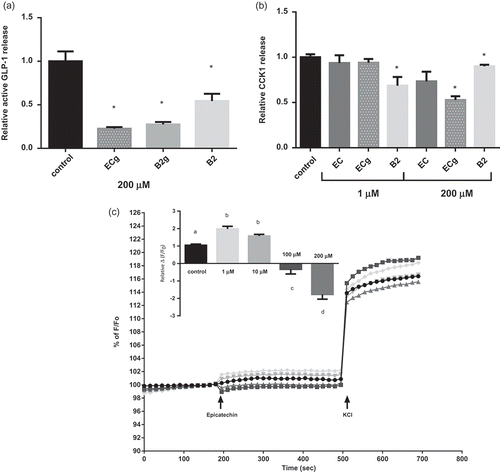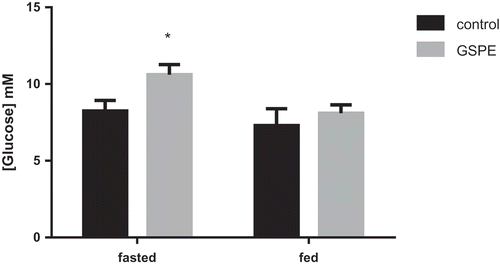Figures & data
Table 1. Increase in enterohormone concentration in the medium due to grape seed proanthocyanidin extract (GSPE) or gallic acid (GA) treatment in explants from different intestinal segments.
Table 2. Glucagon-like peptide-1 (GLP-1) and peptide tyrosine tyrosine (PYY) secretion to the medium in colon explants after 1 h treatment with digested grape seed proanthocyanidin extract (GSPE).
Figure 1. Effects of flavonols on enterohormone secretion and cellular membrane potential in secretin tumour cell line (STC-1) cells. STC-1 cells were treated for 2 h with 200 µM and 1 µM of different flavanols found in grape seed proanthocyanidin extract (GSPE). (a) glucagon-like peptide-1 (GLP-1) and (b) cholecystokinin-1 (CCK1) levels were measured in the culture medium. (c) Effects of flavanols on cellular membrane potential after epicatechin stimulation expressed as % F/F0 and relative Δ(F/F0) (normalized to the control cells) (a), where F is fluorescence at 195 s and F0 is basal fluorescence at 180 s. The data are displayed as the mean ± SEM. *Statistically significant differences versus controls at p < 0.05; a,b,c,dstatistically significant differences at p < 0.05. ECg, (–)-epicatechin gallate; B2g, procyanidin dimer B2–gallate; B2, procyanidin dimer B2.

Table 3. Gene expression of the enterohormones from fasted and fed rats.
Figure 2. Effects of grape seed proanthocyanidin extract (GSPE) on portal glucose. In the fasted group, overnight-fasted animals were treated with GSPE for 1 h. In the fed group, 4 h-fasted animals were treated with GSPE for 1 h, and then administered a food load. Portal glucose levels were measured 20 min after this food load. *Statistically significant differences versus respective controls at p < 0.05.

Table 4. Glucose-6-phosphatase (G6Pase) intestinal activity from fasted and fed rats.
